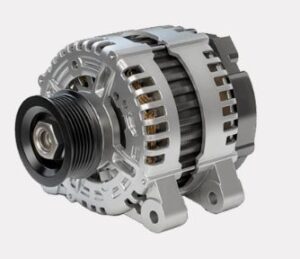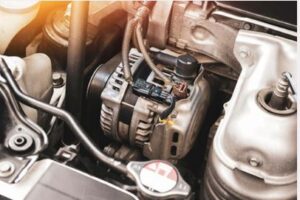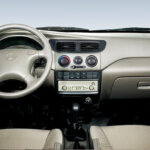Car Alternators A car alternator is a key component in any vehicle’s electrical system. It serves as a generator, converting mechanical energy from the engine into electrical energy. This energy powers your vehicle’s electronics—like headlights, infotainment, AC, and dashboard systems—and keeps the battery charged while the engine is running.
Whether you’re behind the wheel of a Changan Deepal S07, Karvaan MPV Plus, or an Oshan X7 Comfort, understanding how the alternator works can save you from unexpected breakdowns and costly repairs. In this guide, we’ll explore the role of the alternator, signs of failure, wiring basics, voltage output, and more.
How a Car Alternator Works
Located at the front of the engine, the alternator is powered by the crankshaft via a serpentine belt. Inside, a rotor spins within a stator made of copper coils, generating alternating current (AC). This is then converted into direct current (DC) using a rectifier, which charges your battery and powers your vehicle’s systems.
Key Functions of an Alternator:
-
Recharges the battery
-
Powers headlights, infotainment, ignition, and other electrical components
-
Supports vehicle electronics when the engine is on
Electric and hybrid vehicles like the Changan Deepal S07 have advanced energy systems that replace traditional alternators with battery-powered solutions. You can explore the Deepal S07 to learn more about its next-generation powertrain.

When to Replace a Car Alternator
Over time, an alternator wears down and may no longer maintain a sufficient charge or voltage output. Timely replacement is crucial to keeping your vehicle running smoothly.
Common Signs of a Failing Alternator:
-
Dim or flickering lights
-
Battery dying quickly or after short trips
-
Grinding or whining noise from the engine bay
-
Battery warning light on the dashboard
If you’re frequently dealing with dead batteries, it may not just be the battery itself—check if you need a new battery here.

Understanding Alternator Wiring: A Simple Breakdown
A standard alternator wiring diagram includes:
-
Positive Output Terminal – Connects to the battery
-
Voltage Regulator – Controls voltage output (may be internal)
-
Ground Terminal – Connects to the chassis
-
Exciter Wire – Powers the field coil via the ignition switch
Understanding these components is helpful for basic diagnostics, but it’s always best to leave replacements to trained professionals.
Alternator Output Voltage: What’s Normal?
A healthy alternator should produce between 13.5 to 14.8 volts with the engine running. A reading below or above this range indicates an issue with the alternator or the voltage regulator.
How to Check:
Use a multimeter on your battery terminals with the engine running. If the voltage is out of range, your alternator may not be performing optimally.
Common Car Alternator Issues
Routine wear and tear or environmental factors can affect your alternator’s performance. Common problems include:
-
Worn Bearings – Result in grinding noise
-
Faulty Voltage Regulator – Causes overcharging or undercharging
-
Loose Belts – Reduce alternator efficiency
-
Defective Diodes – Drain the battery even when the car is off
These issues can affect any vehicle, whether it’s your everyday Karvaan MPV Plus 1.2L MPFI or the premium Changan Oshan X7 Comfort. If you’re considering an upgrade, check out Karvaan MPV Plus here or explore Oshan X7 Comfort features.
Frequently Asked Questions (FAQs)
What does an alternator do in a car?
It keeps the battery charged and powers electronic components while the engine is running.
What are the signs of a bad alternator?
Dim lights, warning lights on the dashboard, stalling, strange noises, and repeated battery issues.
Is the alternator the same as the battery?
No. The alternator charges the battery but does not store energy like the battery does.
Do electric vehicles have alternators?
Not traditional ones. They use electronic power systems and regenerative braking for energy management.
Can a car run without an alternator?
Only for a short time. Once the battery drains, the car will stall.
What happens when the alternator fails?
The car loses power, electronics shut down, and the vehicle may stop running altogether.
What’s the typical lifespan of an alternator?
Around 7–10 years or 80,000–150,000 kilometers.
How can I test my alternator at home?
Use a multimeter while the engine is on. The voltage should read 13.5–14.8V.
Can I drive with a faulty alternator?
Not safely. You may lose power while driving, especially at night or in traffic.
Is replacing an alternator expensive?
Costs vary by model. Changan South offers professional services at competitive rates. If you’re budgeting for repairs or upgrades, consider checking out our Changan Deepal S07 EMI Plan.
Final Thoughts
A reliable alternator ensures your car performs smoothly and keeps all electronics running efficiently. Whether you’re cruising in an Oshan X7, running errands in a Karvaan, or exploring EV tech in the Deepal S07, staying ahead of alternator issues is key to vehicle longevity.
For alternator inspections, battery replacements, or full diagnostics, visit Changan South — your trusted dealership for quality service and expert care.























